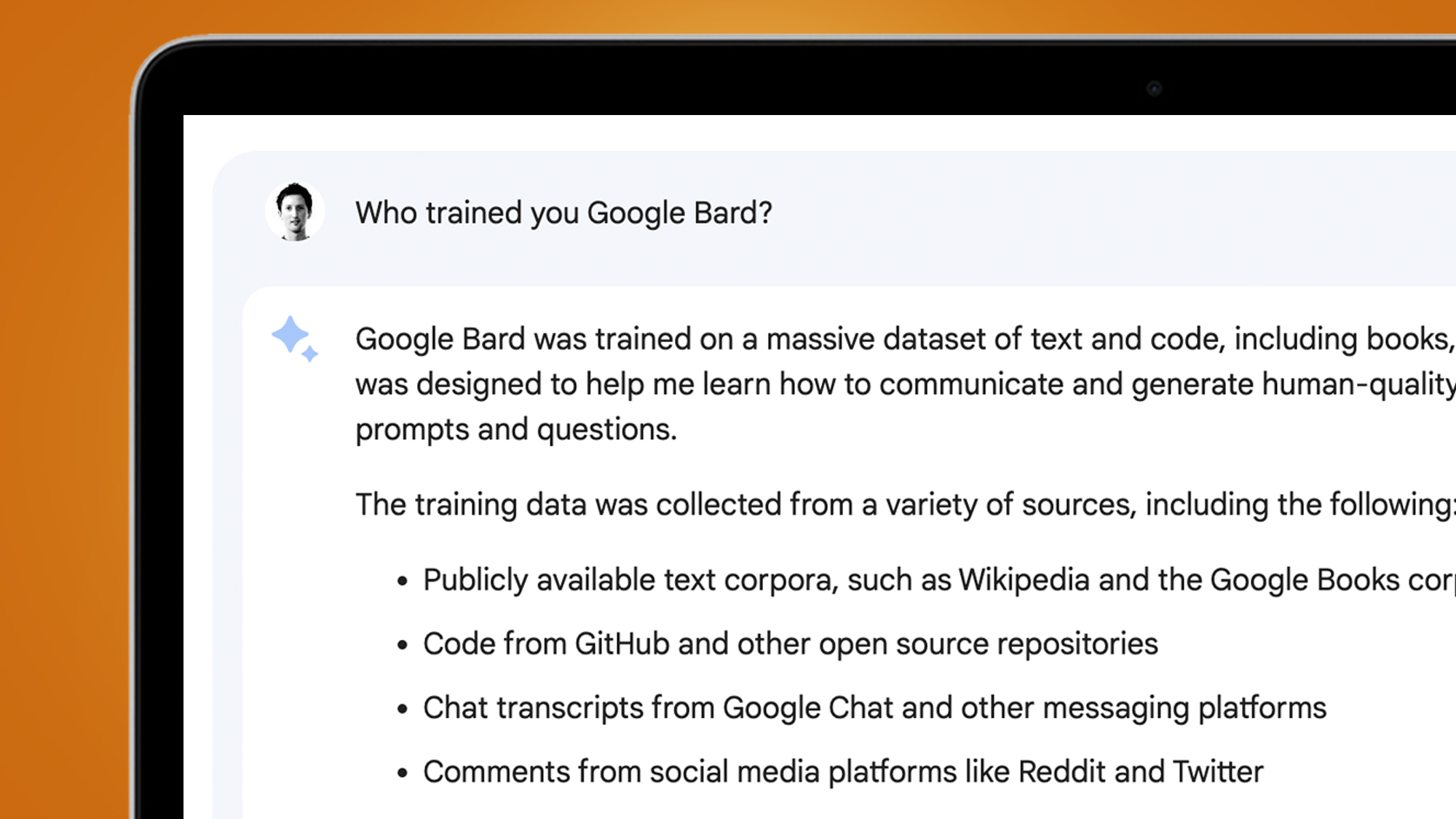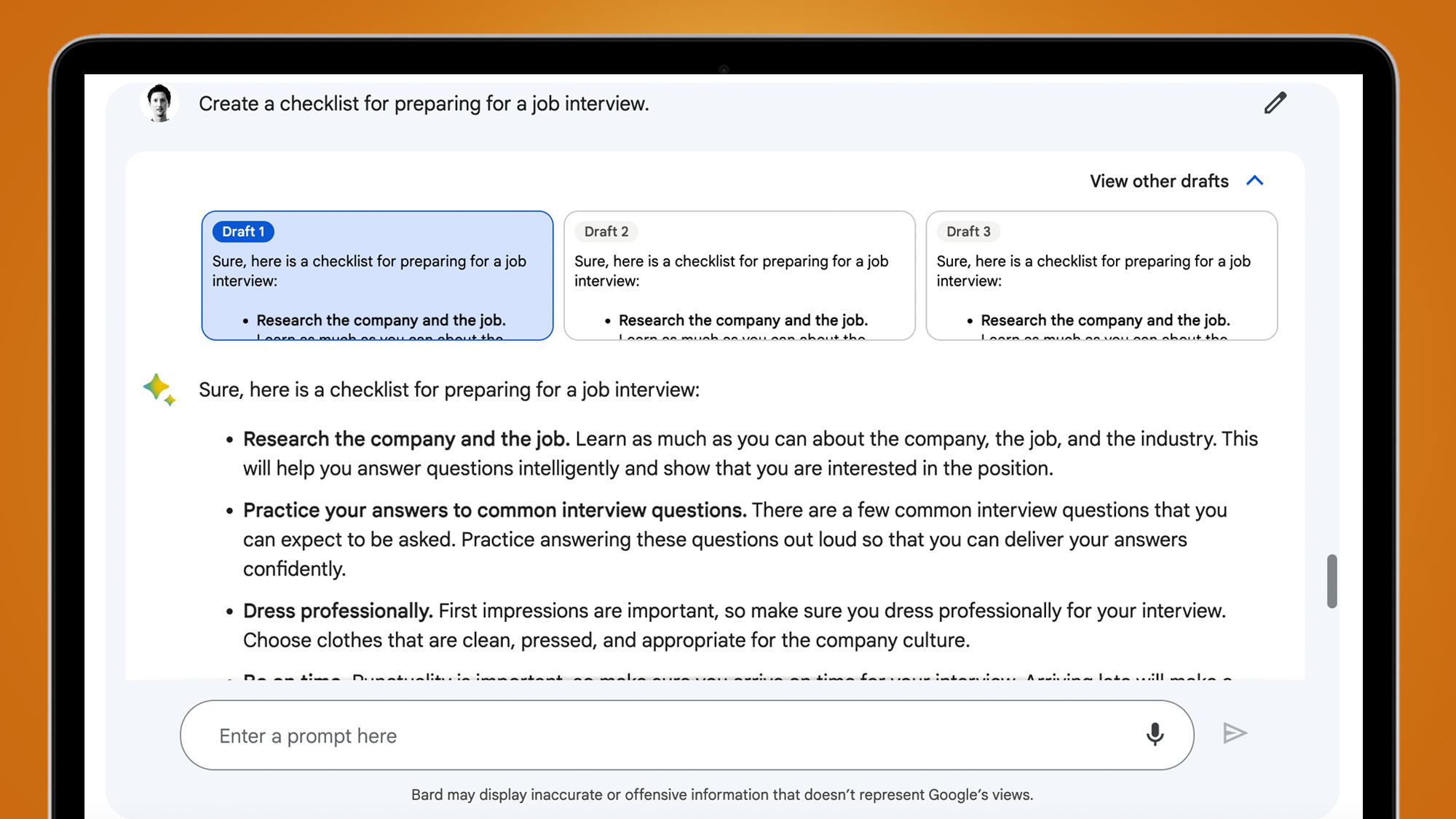5 ways that ChatGPT is better than Google Bard (and 3 ways it isn't)
Google Bard is here, but how does it compare to ChatGPT?

The battle of the AI chatbots has now exploded with the public launch of Google Bard, the search giant's answer to ChatGPT. So how do these two disarmingly human internet companions compare? We've spent hours chatting to both to find out.
Google Bard and ChatGPT look functionally similar, offering you a simple white text box to enter your question. They're also both built on powerful natural language processing engines. But as we've discovered in our hands-on Google Bard review, they're also pretty different AI beasts under the hood.
Google's Bard is based on a lightweight version of LaMDA (Language Model for Dialogue Applications), which was trained on a data set called Infiniset. This data includes a mix of articles and books, but also social media comments on the likes of Reddit and Twitter – which means it's particularly adept at personable dialogue.
Bard is also plugged into the internet, whereas its OpenAI rival isn't (at least, in the same way). ChatGPT's real strength is text generation, which makes it a great creative companion. But while ChatGPT has limited knowledge of the world after 2021, a new Plugins feature lets it connect to third-party apps to tap into up-to-date information (like live prices for flights or hotels).
Both Google Bard and ChatGPT are, then, complementary tools that both have their place. But there's no doubt that ChatGPT is a little further down the road in its evolution – so here are the ways it holds an edge over its Google rival (and a few ways it doesn't).
5 ways that ChatGPT is better than Google Bard
1. ChatGPT is better at coding
One of the ChatGPT's most impressive skills is generating code from your natural language prompts. For example, we've already seen someone use it to create a Wordle rival called Sumplete, and the creative possibilities are endless.
On the other hand, ChatGPT is also far from the perfect programming companion, as we discovered when trying to create a game called Tic-Tac-Go. Whether you're coding in HTML, CSS or JavaScript, the chatbot can end up going down rabbit holes that you'll need to rescue it from.
Sign up for breaking news, reviews, opinion, top tech deals, and more.

But despite ChatGPT's limitations, it's well ahead of Google Bard in this department. Google says that "Bard is still learning to code, and responses about code aren’t officially supported for now". Yet that doesn't stop it trying – when we asked it to help us make the same Tic-Tac-Go game above, it had a good shot.
While Bard spat out some code in different languages, it was incomplete – and the chatbot then essentially opted out of helping us further. So while programming skills are coming to Bard, this one's definitely a win for ChatGPT – particularly since the arrival of its more powerful GPT-4 model as part of ChatGPT Plus.
2. ChatGPT is a creative muse
Looking for an AI sidekick who can help spark creative ideas or analyze your own work? This is another big strength of ChatGPT, particularly compared to the more limited Google Bard.
We have a few authors on the TechRadar team and they've all found ChatGPT to be an excellent partner for generating new ideas based on short passages of writing, or even critiquing their work.

This is partly down to its ChatGPT's comparatively generous input limits. For example, the ChatGPT's free version can process around 2,000 tokens at a time (about 1,500 words), while the paid Plus tier can handle around double that. Google Bard, meanwhile, is limited to 1,000 tokens (or about 750 words) per session.
ChatGPT can also continue a conversation for much longer without forgetting the context. All of which makes it the more powerful tool for generating text, spit-balling new ideas, writing poetry or even helping you write screenplays (albeit with mixed results).
3. ChatGPT is a superior teacher
If you need a complex topic broken down into simple terms – either for you, or a child – then ChatGPT can be an excellent teacher. While you do still need to be wary of so-called hallucinations (when an AI chatbot sounding overly confident about suspect assertions), it is also much better in this department than Google Bard.
For example, ask both AI chatbots to 'explain to an eight-year-old child how waves in the sea are formed' and you'll get quite different answers. While Google Bard answers in a short, staccato sentences, like a weary geography teacher who's dreaming of retirement, ChatGPT answers in a more descriptive, engaging way.


Rather than factual descriptions, ChatGPT will give you helpful analogies like someone throwing a rock into a pond and disturbing the water. It will also throw in related information, in this case noting the influence of the moon and sun on our tides (something that was left out by Google Bard).
In short, ChatGPT feels like an AI chatbot that embraces teaching, whereas Bard feels more like supply teacher who's happier to dish out smaller nuggets of information in a polite way.
4. ChatGPT is multi-lingual
Right now, Google Bard can only converse in US English, though Google says that it's "working to make Bard able to speak as many languages as possible". This is another area where ChatGPT has stolen a march on its rival – it's been trained on data in dozens of languages, including English, Spanish, French, Chinese, Arabic, Japanese and more.
ChatGPT doesn't just understand these languages, it can also generate text in them. For example, you can not only ask it to write you a short history of ChatGPT in French, but solve any grammatical conundrums that you've been stumped by. You may want to double-check their accuracy, but this is something Bard just can't do (yet).

OpenAI's newer GPT-4 model (which is available for ChatGPT Plus subscribers) also supports multiple languages, including relatively niche ones including Welsh and Swahili. This means it's been touted as a potential new tool for preserving endangered languages.
Still, English is both the most commonly-used language on the internet and the main one that ChatGPT was trained on, so its overall performance is better in English than other languages.
5. ChatGPT is simply a lot more... fun
In our experiences, ChatGPT's ceiling for humor and fun is much higher than the more strait-laced Google Bard. It also feels a little more culturally aware than its Google rival, which comes down to its training.
A fun prompt for AI chatbots is asking them to conjure up the dialogue and script for an unlikely movie setting, or one you'd like to see play out in am improv class.


For example, we asked both to imagine a scene where Patrick Bateman from American Psycho has been invited to an after-work social with colleagues who are going axe-throwing. ChatGPT knew the character and gave him some passable lines like this in response to a nervous colleague:
"Patrick Bateman: [smirking] Oh, come on. What's the worst that could happen?"
Google Bard, meanwhile, embarrassed itself by failing to recognize the character and created a dull, generic scene that would have been too safe for Nickelodeon. Whether you're asking it to write a bed-time story or some unlikely song lyrics, it's a similar story – ChatGPT is currently just a lot more creative.
3 ways Google Bard is better than ChatGPT
Google calls Bard "an early experiment that lets you collaborate with generative AI", rather than a chatbot. But despite Google's reticence, Bard does have the edge over ChatGPT in a few ways...
1. Bard is prettier
As we noted in our hands-on Google Bard review, the chatbot's UI is really nice – and it's definitely a step up from ChatGPT's uninspiring design.
Bard's layout is cleaner and its font is more readable and friendlier than ChatGPT, which was originally built as a "free research preview" rather than a consumer app.

You also naturally get a 'Google it' button under each Bard answer, which makes it easier to corroborate or drill down further into information. There's no equivalent in ChatGPT, which only gives you a thumbs up or down next to each answer.
Google clearly expects Bard to be folded into Search sometime in the future, whereas ChatGPT will likely remain a more functional assistant as other apps – like Microsoft's new Bing – build prettier experiences around its GPT engine.
2. Bard gives you multiple answers
One of Bard's more charming idiosyncrasies is that above each answer it gives you a 'view other drafts' drop-down menu. In here, you get two alternative versions of the answer it's given you under the titles 'draft 2' and 'draft 3'.

This is known as 'AI branching' and we think it's a helpful tool, particularly if you're looking to use it for creative reasons like generating a covering letter. We've also already seen this kind of AI-generated drafting previewed for the likes of Gmail and Google Docs, where it's a very natural fit.
On the other hand, it also gives you a lack of confidence in Bard's first answer being the definitive one. And it sometimes feels like the main answer you've been lacks something that's been kept in reserve for its other drafts. It ultimately all comes down to how you're looking to use Bard.
3. Bard is plugged into Google Search
If you're looking to quiz an AI chatbot about recent news events, then Bard is currently a better bet than ChatGPT. That's because, as Google explained, "it draws on information from the web to provide fresh, high-quality responses".
That gives it an edge over ChatGPT, which isn't connected to the internet (at least in the same way) and has, as OpenAI explains, "limited knowledge of world and events after 2021".

This changed slightly on March 23, though, when OpenAI announced new Plugins that allow ChatGPT to connect to third-party apps that offer live information – for example, flight prices on Kayak or restaurant reservations on OpenTable.
This web integration only works with a select list of 12 partners right now, but with OpenAI planning to "roll out larger-scale access over time" ChatGPT could quickly look a lot less isolated than it did when it launched only six months ago.

Mark is TechRadar's Senior news editor. Having worked in tech journalism for a ludicrous 17 years, Mark is now attempting to break the world record for the number of camera bags hoarded by one person. He was previously Cameras Editor at both TechRadar and Trusted Reviews, Acting editor on Stuff.tv, as well as Features editor and Reviews editor on Stuff magazine. As a freelancer, he's contributed to titles including The Sunday Times, FourFourTwo and Arena. And in a former life, he also won The Daily Telegraph's Young Sportswriter of the Year. But that was before he discovered the strange joys of getting up at 4am for a photo shoot in London's Square Mile.